Features of planting and caring for stalked celery in the open field
Petiole celery is characterized by a long growing season and, depending on the variety, ripens in 80-180 days. This feature dictates its own rules for planting a plant. Sowing work begins at the end of January and ends in April, focusing on the climatic characteristics of the growing region and the phase of the moon.
In this article, we will talk about the features of planting and caring for petiolate celery in the open field, methods of bleaching the stems, and the timing of harvesting.
The content of the article
Features of planting stalked celery
Agrotechnical rules of stalked celery:
- soil preparation - plowing and normalizing the pH of acidic soils;
- planting seedlings on the beds from the sunny side;
- maintaining constant soil moisture - without stagnant water and drying out;
- thinning plantings;
- bleaching the petioles to obtain a delicate taste without bitterness;
- feeding with nitrogen and potassium.

Planting dates from seed to seedlings
Sowing dates for celery seedlings depend primarily on the growing region... The varietal characteristics of the culture do not play a special role, in any case, gardeners are guided by the weather conditions of each individual area. Experienced farmers recommend focusing on the lunar calendar.
Depending on the variety
Petiole celery varieties are divided into early and late... In Russia, this type of culture is not very popular compared to root and leaf, therefore, a modest selection of seed material is presented on store shelves. Almost all seeds of stalked celery are imported.
On the packaging, manufacturers indicate the timing of sowing seeds for seedlings and planting in open ground.
For example, the early Malachite variety ripens in 90 days from the moment of germination. In the southern regions, it is rational to produce direct sowing in open ground in mid-May, in other regions, the culture is grown through seedlings. To harvest at the end of August - beginning of September, sowing work begins no later than mid-March.
For reference. Late varieties of stalked celery are sown in February.
From the region
To calculate the sowing period of stalked celery, such factors are taken into account:
- seed germination period - 7-14 days;
- landing in the ground, warmed up to a minimum temperature of + 6 ° С;
- the appearance of 4-5 true leaves in 60-70 days.
Adding the seedling time and the time required for seedling to emerge, a total of about 84 days is obtained. Based on this, the sowing of stalked celery is carried out on the twentieth of February.
In regions with late spring and frequent frosts in May, the dates are shifted to late February - early March. Planting in the ground is carried out in late May - early June.
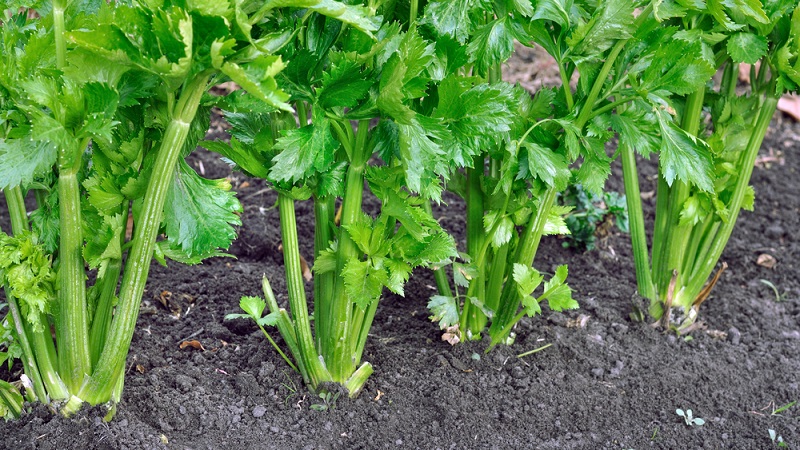
Approximate dates for sowing stalked celery:
- in the south - late March - early April;
- in the regions of the middle zone - March;
- in the north - February - the first decade of March.
Lunar calendar
Favorable days for sowing stalked celery by phases of the moon for 2020:
- in February: 1-7, 24,25, 28, 29;
- in March: 2-6, 17.18, 27-30;
- in April: 1, 2, 5-8, 14, 24, 28;
- in May: 2, 3, 5-7, 25, 26, 30, 31.
Planting seeds for seedlings
Growing stalked celery through seedlings - painstaking work.However, to obtain a high-quality harvest, you cannot do without it. Seed material and soil are prepared in advance.
Seedling care is based on timely watering, maintaining optimal air temperature and illumination, making additional fertilizing.
Seed and soil preparation
The quality of the seeds affects the final result - plant health, stalk thickness, taste and aroma. To get the desired result pay due attention to the selection of planting material:
- purchase of fresh seeds, the expiration date of which ends next year;
- selection of material of Dutch selection with high yields;
- selection of early varieties with a full ripening period of about 90 days.
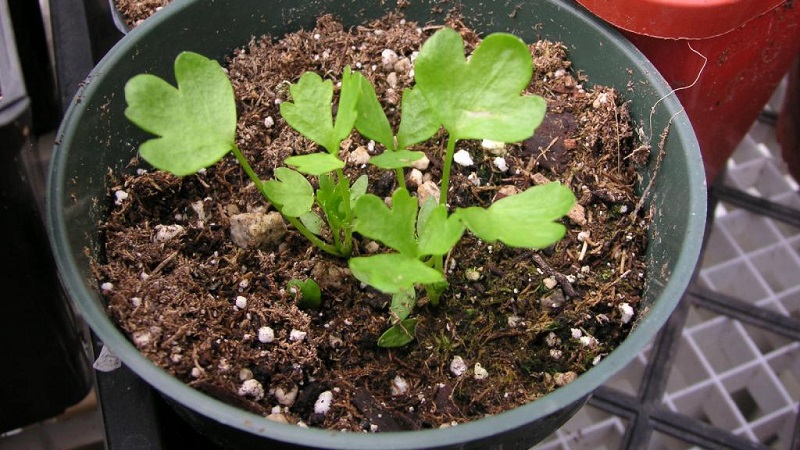
Seeds are stratified before sowing: soaked in warm water for 24 hours, wrapped in gauze soaked in water, and left in a warm room for a week. Then the tissue with the seeds is placed in the refrigerator for 2 weeks. This allows you to create natural conditions: the seeds overwinter in the soil, and in spring they sprout together.
Suitable for growing seedlings ready-made substrate from a gardening store or soil mixture, prepared with your own hands. In a large bucket, mix turf, river sand, peat, sawdust and crushed eggshells in equal proportions.
Mixture options for seedlings:
- peat, vermiculite, humus (3: 1: 1);
- peat, humus, wood ash (3: 1: 1);
- biohumus and sand (1: 1).
The mixture is poured with a hot solution of potassium permanganate or disinfected with "Fitosporin".
Sowing
Clean containers (boxes, tetra packs, pots, trays) are filled with moist soil, the seeds are sealed to a depth of 0.5 cm and poured with warm water through a sieve. Put glass on top or stretch a film.
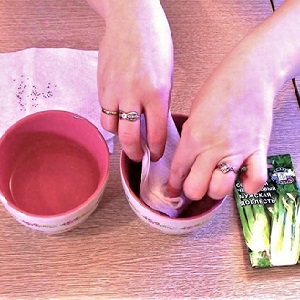 Pure snow is used instead of water. A layer of snow is placed on the ground, seeds are spread on top. The melt water pulls the seeds with it, creating natural conditions favorable for the growth of seedlings.
Pure snow is used instead of water. A layer of snow is placed on the ground, seeds are spread on top. The melt water pulls the seeds with it, creating natural conditions favorable for the growth of seedlings.
Snails are used to grow strong stalked celery seedlings... To twist the rolls, take dense cellophane or a substrate under the laminate and fix them with elastic bands.
A 10 cm wide tape is cut out of the backing or cellophane, a 1 cm layer of soil is poured on top. Sprouted seeds are carefully spread with tweezers with an interval of 1-2 cm, stepping back from the edge of the film 2 cm.The tape is carefully folded and secured with rubber bands. The snails are placed in wide trays with the seed side up. The film is pulled from above.
Seedling care
The film is not removed until sprouts appear. The boxes are kept in a dark room with an air temperature of + 20 ... + 22 ° С, then transferred to the windowsill.
As soon as the first leaves hatch, the temperature is reduced to + 12 ... + 16 ° С, and after 10 days it is increased to + 20 ... + 25 ° С. Fortified seedlings of stalked celery with 3-5 leaves are transplanted into individual glasses with a capacity of at least 300 ml, choosing the strongest seedlings.
The container is filled with a substrate, 2-2.5 cm depressions are formed and watered with clean water. The seedlings are carefully dripped in with a teaspoon and transferred. Sprinkle soil on top. Seedlings are watered with water at room temperature.
Reference. The norm of daylight hours for stalked celery is 14 hours. The optimum air temperature is + 18 ... + 22 ° С.
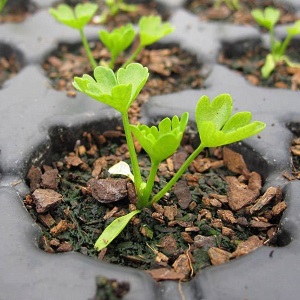 Seedlings watered gently, through a sieve, 1-2 times a weekmixing Fitosporin-M into water. The substrate is loosened with a peg without touching the roots.
Seedlings watered gently, through a sieve, 1-2 times a weekmixing Fitosporin-M into water. The substrate is loosened with a peg without touching the roots.
Top dressing of seedlings:
- two weeks after sowing - chicken droppings (1 tsp for 3 liters of water);
- then every 10 days - "Nitrofoska" (1 tsp for 3 liters of water).
20-25 days before being transferred to an open area, the seedlings are taken out to the balcony for hardening.
Sowing time in open ground
Early varieties are planted directly in the ground with seeds in the second decade of April. This method is used in the south of the country, but it also has its own risks.:
- there is no guarantee of friendly shoots, even taking into account the preliminary preparation of seed material;
- caring for young plants is hampered by the slow germination of seeds, therefore, the fight against weeds is carried out extremely carefully;
- protecting delicate seedlings from weather surprises is problematic.
Petiole celery seeds are planted in open ground in the south, taking into account weather conditions and the lunar calendar. Favorable days for sowing in April: 1, 2, 7, 8, 14, 24, 25, 26, 27, 28.
Sowing in open ground
Seeds for direct sowing in the garden are prepared in the same way as for growing seedlings. To speed up the process of awakening the planting material, in addition to stratification, additionally carry out:
- soaking in warm water for 5-7 days;
- germination in a damp cloth or gauze for 7-10 days (the water is periodically changed);
- soaking in hot water at a temperature of 50 ° C (the seeds are placed in a linen bag);
- germination in wet sawdust.
After all procedures, the seed is dried.
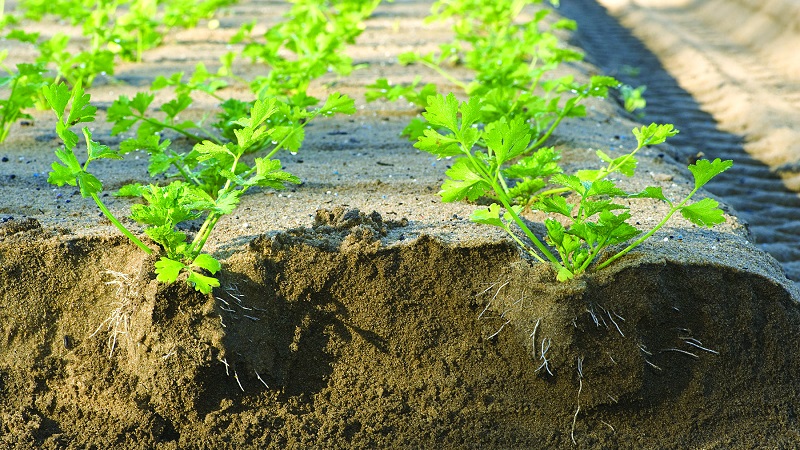
Pre-preparation accelerates germination... Seedlings appear two weeks earlier than expected.
For direct sowing of seeds in open ground, the site is prepared in the fall: carry out deep plowing and fertilize with humus. In the spring, the land is plowed again, loosened and the beds are watered with a solution of potassium permanganate or copper sulfate.
Sowing scheme and technology
Sowing seeds carried out after warming up the soil to + 10 ° С... In the southern regions, this occurs in mid-April. Furrows are made in the soil with a depth of 1-1.5 cm, wood ash is poured and the seeds are sealed with an interval of 2-3 cm. Sprinkle on top with a layer of peat and watered abundantly with warm water.
To protect against night frost, the beds are covered with black agrofibre.
Planting and caring for stalked celery in the open field
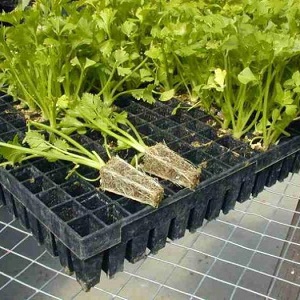 The transfer of stalked celery begins when the height of the seedlings reaches 20 cm... The best period for planting is late April - early May, depending on the region.
The transfer of stalked celery begins when the height of the seedlings reaches 20 cm... The best period for planting is late April - early May, depending on the region.
Optimal conditions for the growth and development of culture - moderate air temperature and sufficient soil moisture.
Ideal soil for growing - light sandy loam, rich in organic matter. The best predecessors of the culture are cabbage, potatoes, zucchini, cucumbers.
The acidity of the soil is neutral (pH = 6.8-7) or slightly acidic (pH = 5.6-6.0). Celery grows slowly on acidic soils. To normalize acidity, dolomite flour, chalk, lime, ash are added to the soil.
Deep plowing in autumnfertilizing the soil with humus, fermented food waste, compost.
In the spring they plow again, loosen and spill the soil with a dark solution of potassium permanganate... Depressions of 25-30 cm are formed at a distance of 40 cm. The row spacing is 60 cm. Wood ash is placed on the bottom, a layer of soil is poured on top so that the level of the furrows is 8 cm below ground level.
The seedlings are carefully taken out of the glasses together with an earthen clod and transferred into the furrows. The beds are mulched with sawdust or straw.
Stalked celery care:
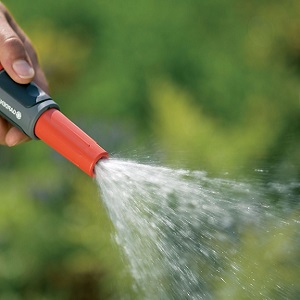 Watering 2-3 times a week. Stagnation or water shortages should not be allowed.
Watering 2-3 times a week. Stagnation or water shortages should not be allowed.- Loosening and weeding as needed. Treatments provide additional aeration to the root system
- Remove side shoots as they grow. Cut off yellow, unsightly and thin stems with a sharp knife, leave thick and strong.
- Petiole celery needs to be fed weekly, alternating potassium and nitrogen fertilizers: Superphosphate or Nitrophoska (25 g per 10 l of water), nettle infusion, biohumus, urea solution (10 g per 2 l of water).
Protection against diseases and pests
The table shows the main diseases of stalked celery and methods of dealing with them.
| Name | Signs | Treatment | Prevention |
| Rust | Brown spore pads on stems and leaves | Fitosporin |
|
| Septoriasis | Yellow spots on leaves, brown-brown spots on stems | "Fundazol" or "Topsin-M" 20 days before harvest | |
| Cercosporosis | Light spots 5 mm in diameter with a brown border | "Fundazol" or "Topsin-M" 20 days before harvest | |
| Peronosporosis | Whitish fleecy bloom on leaves and petioles | Sow thistle infusion (300 g per 5 liters of water, leave for 8 hours) | |
| Cucumber mosaic | Rounded rings on foliage, plant growth retardation | Does not exist, diseased plants are completely removed from the beds |
Most often, petiolate celery is affected by celery and carrot flies, bean aphids.
To get rid of insects:
- onions are planted nearby;
- dust the plants with a mixture of dry mustard, sand, tobacco dust (1: 1: 1);
- water the beds with dandelion infusion (0.5 kg of flowers per 10 liters of water);
- plants are treated with infusion of orange peel (300 g of peel per 3 liters of water).
It can be useful:
Bleaching stalked celery
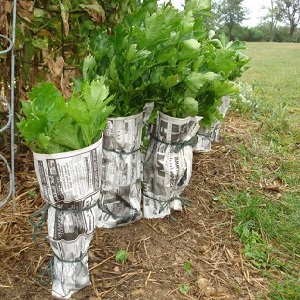 The bright green stems have a pungent aroma and bitter taste. To give the petioles a pleasant taste at the last stage of the growing season, a bleaching procedure is carried out.
The bright green stems have a pungent aroma and bitter taste. To give the petioles a pleasant taste at the last stage of the growing season, a bleaching procedure is carried out.
Stems 30 cm high gathered in a bun and loosely tied with strips of fabric or rope... Then they are wrapped with the materials at hand so that the wrapper fits snugly to the ground.
Use as a wrapper newspaper, wrapping paper, cardboard, straw, pipes, tall boxes, penofol. Dark film is not used - the petioles quickly rot in such a wrapper.
Reference. Classic petiole bleaching provides for high hilling. However, gardeners did not like this method because of the unpleasant earthy taste that the stems subsequently acquire.
Harvest time
The harvesting of stalked celery depends on the ripening period... The early varieties ripen in July - September, the late ones - in October - November.
It is important to collect the petiolate variety before the onset of frost. due to rapid wilting in the cold and loss of taste.
Reference. The main signs of the technical ripeness of the petioles are the white color of the stems and the loss of a sharp, spicy aroma.
Re-forcing the stem
In English, there is a word regrowing - literally translated as "re-cultivation." To do this, cut off the lower root part, put it in a container of a suitable size (mug, glass), pour water to half of the outlet and put it on the windowsill.
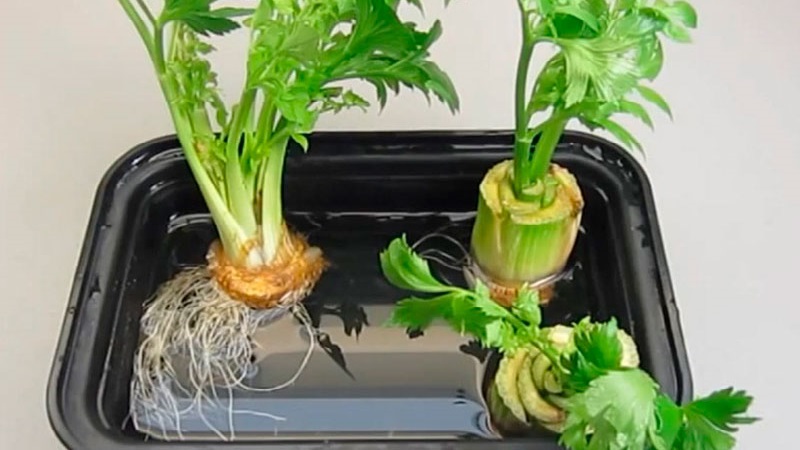
Water is periodically added and waited for seedlings... After 2-3 days, green leaves will appear, and after 1-1.5 weeks - branches of greenery.
Conclusion
Planting stalked celery for seedlings is the best way to get a rich harvest due to the long growing season. Direct sowing of seeds is carried out only in the southern regions, but even in such conditions it is not always possible to achieve the desired result. Sowing dates for seedlings differ depending on the region. In cold regions (Siberia), sowing begins in January - February, in the Moscow region - in March, in the south - in April. Varietal characteristics are rarely taken into account.
The main task of the gardener is to start sowing work on time, having previously prepared the material. Care procedures after planting seedlings in open ground are aimed at sufficient watering, feeding, weeding, loosening, bleaching the petioles.